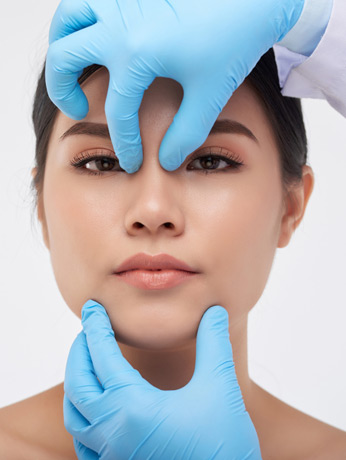Nasal Surgery Beverly Hills
Patients undergo nasal surgery in Beverly Hills for a variety of reasons. Some need rhinoplasty to correct medical conditions, while others would like to make cosmetic adjustments.
Conditions Corrected By A Rhinoplasty

Rhinoplasty can correct the following conditions:
Enlarged Turbinates. Also known as nasal turbinate hypertrophy, enlarged turbinates can cause breathing problems, nosebleeds, and frequent infections. The condition may be caused by seasonal allergies, environmental irritants, infections, stress, weather changes, hormonal changes, severe allergies, anatomic issues with the nose, and chronic sinus inflammation.
Turbinate rhinoplasty can shrink turbinates that have become swollen. During rhinoplasty, the surgeon may fracture the turbinates outward and reposition them to help improve breathing and retain the benefits of functional turbinates.
Nasal Polyps. These soft, noncancerous growths are located in the lining of the nasal passages or sinuses and may form as a result of allergies, recurring infection, asthma, drug sensitivity, chronic inflammation, or an immune disorder. During rhinoplasty, the surgeon will use a snare instrument to remove them.
Nasal Fractures. Depending on the type of nasal fracture, patients will require a specific type of rhinoplasty. Patients may need to find a specialist to perform this type of nasal surgery in Beverly Hills.
Cosmetic Adjustments
Patients may decide to undergo rhinoplasty to enhance certain features and minimize imperfections in the three different parts of the nose: the upper vault (also known as the bony vault), the middle vault, and the lower vault.
Radix Correction. The upper bony portion of the nose is called the radix. This part of the nose and underlying cartilage may be unusually large and cause a bump. Or, the radix can be shallow and cause a depression. A rhinoplasty can correct both of these issues, either by shaving away small portions or adding volume by using the patient’s own cartilage.

Straightening. A slightly crooked nose can be straightened by removing part of the bone or cartilage, or by shifting the tissue into proper position. Some patients may need a splint to hold the nose in place while it heals.
Tip Rotation and Reduction. If the tip of the nose is turned too far upward or downward, then the surgeon will reshape the underlying cartilage.
Projection Adjustment. If the tip of the nose projects too far outward from where it meets the upper lip, a rhinoplasty surgeon will trim a portion of the cartilage. To increase projection, the surgeon will separate and realign the cartilage at the tip of the nose to help push it forward.
Width Reduction. The pyriform aperture is a triangle formed by the nostrils and the tip of the nose. A rhinoplasty surgeon can reduce the width of the tip of the nose by making the angles of this triangle steeper at the point where the nostrils meet the face.
The “ala” are the outer edges of the nostrils. Adjusting the ala involves reducing wide or flared nostrils.
During this type of nasal surgery in Beverly Hills, the surgeon will remove a portion of tissue to change the level of tension responsible for creating excessive flair in the nostrils. A special technique, called the Weir technique, involves removing tissue to create a wedge-shaped void and closing it with sutures.
